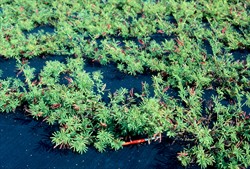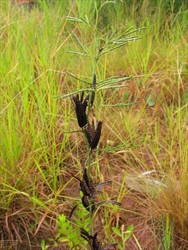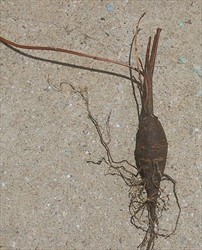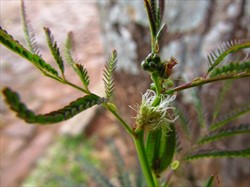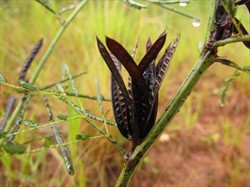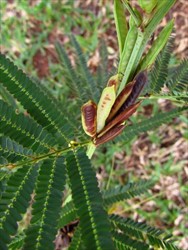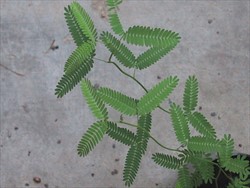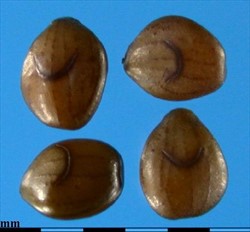Desmanthus tatuhyensis
Tropical Forages
Desmanthus tatuhyensis Hoehne
Subordinate taxa:
Desmanthus tatuhyensis Hoehne var. brevipes (B. L. Turner) Luckow
Desmanthus tatuhyensis Hoehne var. tatuhyensis
Note: Luckow (1990) comments that, based on herbarium specimens, there is an apparent intergradation between D. acuminatus and D. tatuhyensis and that the latter might be treated as a variety of the former.
var. brevipes: Basionym: Desmanthus brevipes B.L. Turner
Family: Fabaceae (alt. Leguminosae) subfamily: Caesalpinioideae (mimosoid clade*) tribe: Mimoseae.
* Azani, N. et al. [97 authors from 54 institutions] 2017. A new subfamily classification of the Leguminosae based on a taxonomically comprehensive phylogeny. Taxon 66: 44–77.
A prostrate to erect perennial herb to 40 (–80) cm tall, usually with 2–4 branches from the base. Taproot to 9 (–11) cm long, 7–25 mm diameter, napiform, woody, bark smooth, orange to dark brown. Young stems green, strongly angled with corky ridges, sparsely pubescent along the ribs; older stems glabrous, angular, green or brown. Stipules persistent 2.0–4.0 mm long, setiform, with membranous wing opposite the petiole. Leaf paribipinnate 2.3–7.5 cm long, petiole 5–11 (–14) mm long, rachis 12–25 mm long; with 1–4 (–5) pairs of pinnae 21–42 mm long, oblong, pinnules gradually decreasing in length distally; nectary red or green, 1.4–3 mm diameter, sessile, elliptic, crateriform or flattened, inserted between the lower pair of pinnae; pinnules19–38 pairs of leaflets/pinnae 3.0–4.2 mm long and 0.7–1.3 mm wide, linear oblong. Capitulum (flower head) 0.5–0.7 cm long, borne singly in leaf axils on peduncles 0–5 mm long; heads comprise 7–9 (–11) perfect, functionally male or sterile flowers; sterile flowers rare, at base of the head; male flowers 0–2, occur towards the base of the head, above the sterile flowers, but below the perfect flowers; perfect flowers 5–8, occur apically. Fruiting peduncles 0–1.0 cm long bearing 1–11 pods; pods 3.1–5.0 cm long, 3.1–3.3 mm wide, linear, black-brown at maturity, opening along both sutures. Seeds 7–18 per pod, 1.9–2.6 × 1.5–2.2 mm, plump, ovate, golden-brown.
var. tatuhyensis: plants erect; at least some leaves with >2 pinnae; heads without sterile flowers.
var. brevipes: plants prostrate to ascending; leaves with 1–2 pinnae; heads usually with 1–2 sterile flowers.
Note: Above varieties based on Luckow (1993). There is some doubt over the requirement for the varietal distinction as it is based on continuous variables. Growth habit of some accessions does not conform to this varietal distinction.
English: dwarf bundleflower (possibly more appropriately applied to var. brevipes)
Latin America: anil-de-bode, angiqueto, angiquilho, angiquinho (also applied to other pinnate species incl. Aeschynomene and Calliandra, and other Desmanthus spp.) (Brazil)
var. brevipes
Native:
Northern America: USA (Texas)
South America: Argentina (Córdoba, Chaco, Corrientes, Formosa, Jujuy, Santa Fe, Santiago del Estero, Tucumán)
var. tatuhyensis
Native:
South America: Argentina (Corrientes, Formosa, Misiones); Brazil (Paraná, Rio Grande do Sul, Santa Catarina, São Paulo); Paraguay (Alto Paraguay, Itapua, Misiones, Presidente Hayes); Uruguay
Forage
The low stature of this species has not attracted research attention. However, it is well-eaten and has survived in heavily grazed pastures on acid soils in mesic environments. Has the potential to improve production by raising the protein level in the diet, as do other low-statured legumes such as Aeschynomene falcata and Stylosanthes guianensis var. intermedia.
Var. tatuhyensis occurs in dry grasslands, cleared fields and at roadsides at altitudes of 400‒1,200 m asl.
Var. brevipes occurs in grasslands, beaches, roadsides and bay fronts in southern coastal Texas (USA), and in disturbed areas and roadsides in both Texas and the Chaco region of Argentina and Paraguay at elevations of 0‒1,150 m asl.
Soil requirements
Commonly found on sandy or gravely soils, but also found on clays and clay-loams. It has been collected in saline soils.
Moisture
Adapted to moderately humid environments, with specimens collected in humid meadows and periodically flooded soils from regions with mean annual rainfall between 800 and 1,700 mm.
Temperature
Most collections have been made between latitudes 27 and 30° N in the USA and 21 and 31° S in South America, where average annual temperatures range from 20 to 26 °C.
Light
May possess some shade tolerance because of its natural occurrence under low woodlands.
Reproductive development
Flowering and fruiting occur from September through to April in south-eastern Brazil and Paraguay, and October-November through to May in Argentina. Var. brevipes flowers and sets seed after rain in Texas from June to October with a peak in August.
Defoliation
Less erect types have proven very tolerant of grazing.
Fire
Laboratory tests using heat shock treatments up to 150 °C for one minute, did not break dormancy of D. tatuhyensis seed, nor did they kill the seed, suggesting the rapid passage of fire in Brazilian subtropical grasslands is unlikely to influence seedling recruitment.
Guidelines for establishment and management of sown forages.
Establishment
Very limited evaluation has been conducted with D. tatuhyensis. See requirements for other Desmanthus spp. as a guide.
Fertilizer
No information available.
Compatibility (with other species)
Found growing in association with low-growing tussock and sward-forming grasses and legumes.
Companion species
Grasses: Aristida sp., Axonopus fissifolius, Cynodon dactylon, Paspalum notatum, Setaria sp.
Legumes: Desmodium incanum, Mimosa sp.
Pests and diseases
None recorded.
Ability to spread
No indication of spread.
Weed potential
Most likely very low.
Nutritive value
Very limited evaluation has been conducted with D. tatuhyensis. See values for other Desmanthus spp. as a guide.
Palatability/acceptability
Well eaten.
Toxicity
None recorded.
Dry matter
Accessions assessed in Australia were of low to moderate productivity.
Animal production
No reports of animal production data were cited.
No breeding programs have been undertaken. However D. tatuhyensis has been collected in conjunction with selection programs examining D. virgatus[1] [2] [3], D. pubescens and D. leptophyllus. Using RAPD marker analysis, D. tatuhyensis has been shown to have affinities to D. leptophyllus as well as to D. acuminatus and D. paspalaceus, the latter two having almost sympatric distribution with it in Paraguay, Uruguay, Argentina and Brazil. Chromosome number of var. brevipes is 2n = 28; unknown for var. tatuhyensis.
While no data have been published for this species, its low growth habit and pod density relative to other Desmanthus species listed suggests total annual seed yields would be of the order of 100‒200 kg/ha, and that even with vacuum harvest equipment, commercial yields would be substantially less.
No information available.
- May have greater tolerance of acid soil conditions.
- Can compete with low, sward-forming grasses.
- Persistence under grazing.
- Largely low productivity.
Luckow, M. (1993) Monograph of Desmanthus (Leguminosae-Mimosoideae). Systematic Botany Monographs Vol. 38. American Society of Plant Taxonomists, Laramie, WY, USA. doi.org/10.2307/25027822
None released to date.
CPI 25840 (origin Uruguay), CPI 37538 (origin Córdoba, Argentina), CPI 40073 (origin Rio Grande do Sul, Brazil), all D. tatuhyensis var. tatuhyensis and morphologically similar, selected in Australia. CPI 37538 is a small type that persisted strongly on an acid soil in association with Axonopus fissifolius, at a humid, subtropical site in Australia (Gympie) where other Desmanthus accessions were chlorotic and weak. Growth of CPI 37538 was not particularly vigorous, but its acid-soil tolerance is significant.
